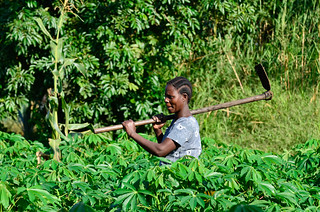
 Cassava is the second–most important food crop in Africa, a staple in South America, and a vital industrial crop grown by smallholders, particularly in SE Asia. Recent research at CIAT also established that cassava possesses exceptional ability to thrive in tough conditions, including the higher temperatures and drought conditions predicted as a consequence of climate change – meaning it could be a key fail-safe crop for farmers in Sub-Saharan Africa.
Cassava is the second–most important food crop in Africa, a staple in South America, and a vital industrial crop grown by smallholders, particularly in SE Asia. Recent research at CIAT also established that cassava possesses exceptional ability to thrive in tough conditions, including the higher temperatures and drought conditions predicted as a consequence of climate change – meaning it could be a key fail-safe crop for farmers in Sub-Saharan Africa.
But cassava has one enduring weakness – its vulnerability to pests and diseases, which can cripple production, and prevents millions of farmers maximising the crop’s potential. A new CIAT project to develop an advanced self-defence reflex for cassava could enable the crop to resist devastating attacks from some of its most damaging pathogens.
From hunter to hunted
The new project aims to exploit an essential survival mechanism in the plant to help it to seek-and-destroy hostile viruses. Scientists will duplicate a protein in the plant that normally sends instructions for it to consume and recycle damaged parts of its own cells to cope in times of stress – for example, when food is scarce. This natural process is called autophagy. The duplicated protein will be programmed to recognise invading viruses as ready for recycling, escorting them to the autophagy system.
“The protein would act like a highly-efficient nightclub doorman,” explained Wilmer Cuellar, CIAT plant virologist and the project’s principal investigator; “It would intercept the unwelcome guest and usher it directly to the autophagy system. Both the invading virus and the protein are recycled in the process – the plant using both as food. It could be a robust self-defence reflex that completely turns the tables on viruses, transforming them from predators to prey.”
Dr Cuellar and his team will begin testing the idea on two of the most severe cassava viruses found in Sub-Saharan Africa and the Americas: cassava mosaic disease (CMD), and cassava frogskin disease (CFSD), both of which can significantly reduce cassava yields.
“There are very few strategies for tackling cassava viruses,” explains Dr Cuellar. “If we’re successful, this could be a very powerful mechanism for keeping some of the crop’s most damaging aggressor at bay.”
The year-long proof-of-concept Engineering Selective Autophagy for Virus Elimination in Cassava project will begin this month, with a USD$100,000 grant from the Grand Challenges Explorations (GCE) initiative of the Bill & Melinda Gates Foundation. GCE funds research into innovative approaches to some of the world’s toughest and persistent global health and development challenges by investing in the early stages of bold ideas that have real potential to solve the problems people in the developing world face every day. The project is one of over 80 GCE Round 9 grants announced by the Foundation.
“It’s really exciting,” says Dr Cuellar, “not just because we’ll be applying cutting-edge science to improve the resilience of one of the world’s important food crops, but because the same mechanism could be applied in other crops, and used to eliminate many kinds of hostile viruses – not only those affecting cassava.”
This article is adapted from a piece by Neil Palmer first published on the CIAT Blog on 1st November 2012.